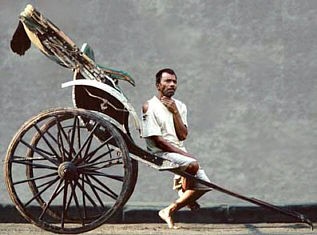Rickshaw by Lao Long
February 2003
The mystique of the rickshaw has captured the western imagination since the turn of the century, bringing to mind exotic images of passengers being pulled through crowded markets of the Orient.

Rickshaws and their riders have been studied by engineers, evaluated by transportation economists and analyzed by sociologists. They are featured in numerous movies, and as the authors discover, are still an enormously popular form of transport ideally suited to the scale and traffic patterns of many Asian cities.
At the turn of millennium, the western world is looking towards the developing countries for ecologically sound and sustainable solutions that have been a part of the day-to-day life in this part of the world. One such thing is the cycle rickshaw, a mode of transportation in the whole of Asia and more so in the Indian sub-continent.
Also known as trishaws, sidecars, pedicabs, cyclos, becaks and a host of other local names, the cycle-rickshaw is much more than just a means of transport.
Who invented it?
Disputes over who actually invented the rickshaw come as little surprise as American missionary contend with three Japanese locals, all of who claim to have had the initial concept behind the invention. Jonathon Goble, an American Baptist minister, is said to have devised the contraption when the health of his sick wife deteriorated and she was unable to walk, he proceeded to decide to market his new idea but the blueprints he passed onto Shimooka Renjo got misplaced resulting in the loss of a possible new-found fortune.
A few months later independent of this, three Japanese people named Izumi Yosuke, Suzuki Tokujiro, and Takayama Kosuke, came up with the idea collectively drawing inspiration from the Western horse drawn carriage, the man pulled and pushed dray and the old kago bearers.
History of Rickshaw in China
The first rickshaw in China was imported from Japan in 1874 and become the most popular way of transportation, for rich Chinese and all the foreigners.
From the day Chairman Mao?s portrait rose over Tiananmen Square, the rickshaw seemed doomed. A rich man’s lounge chair on wheels, drawn by poor boys or desiccated old men, the West viewed it as the ultimate symbol of ?coolie culture? and China?s subjugation.
Mao was determined to eradicate capitalist “evils” from Communist China. So, for most of the past 50 years, the rickshaw had been relegated to China’s museums and history books—even as it has become a familiar sight in tourist centers around the world.
In recent years, however, the rickshaw has made a comeback, quietly rolling back into the heart of Beijing. It may be considered a novelty elsewhere, but the shiny contraption with a yellow top painfully reminds the Chinese of a time when they were seen as little more than beasts of burden.
History of India’s Cycle rickshaw
Originally brought to India by Chinese immigrants, rickshaws were a major technological advance over the sedan chair, or palanquin, found in 19th century Europe and Asia. Rickshaw?s required only one puller, compared with the two to four footmen required to carry a single person on a palanquin. Rickshaws became the favored form of transport for the middle and upper classes, not just in India, but across Europe as well. By the turn of the century, the man-powered rickshaws substituted by bicycle-powered rickshaws.
Cycle rickshaw first came into existence in India in the early forties of the last century. They were of great technological improvement over the large, inefficient, wooden wheeled hand pulled rickshaw that can be still seen in many Asian cities. It also gave a certain amount of dignity to the profession by making the service provider, a driver rather than a puller (though the word is still widely used which seemingly is a term borrowed from the hand-pulled rickshaws).
Traditionally, cycle rickshaws in India can be seen in almost every nook and corner of the country. And when one looks at them closely there is a great variation in them. Some are narrow, some are wide, and a few have a covered top while at many places the top has been done away with. Ornamentation and decoration varies from region to region.
Tricycle History
In 1933, the tricycle known better as trishaw was born in Thailand for first time in Nakhon Radchasrima by a engineer group director, Mr. Loean Pongsopha. He did it by take a rickshaw car combine with a bicycle in to the tricycle. Later this tricycle was upgraded by adding the wheel aside. This tricycle was usually used in the South Part of Thailand. In late 70?s Thai trishaw was upgraded by adding a motor engine on the tricycle. So, red tricycles used for send and receive goods and TUK-TUK tricycles are very popular among tourists.
Nowadays Tuk Tuk tricycles called Deluxe TUK-TUK, because they have added mobile, karaoke, computer etc The latest improvement for the Tricycles are the Skylab?s which they have car engines. Skylab was born in Udontani Province and it is the most colorful tricycle in the world.
Source : http://www.newsfinder.org/site/more/rickshaw/
Website Designed by Gautam Chaudhary
Except as noted, this work is licensed under a Creative CommonsAttribution-NonCommercial-NoDerivs 3.0 Unported License.



